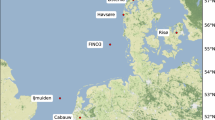Abstract
This paper shows the possibilities of a procedure for estimating near-surface wind statistics, by means of the numerical integration of a simple boundary-layer model with a second-order turbulent closure. Standard and easily available synoptic data are used as initial and boundary conditions.
The development of this methodology is impelled by increasing requirements of a quick and precise knowledge of the wind characteristics in many regions of South America, which confronts the serious limitation of a reduced number of extended observational series, scattered over a vast continent.
In order to evaluate the methodology, near-surface wind statistics from observed data at two locations are compared with model output statistics. Relative errors are about 0.2 for daily mean velocities and about 0.1 for weekly mean velocities, observed and computed time series being highly correlated in both cases. Calculated frequency distribution of wind directions is in good agreement with the observed one, and the absolute mean error in the daily mean wind direction is about 20 deg.
Even though a wide variety of large-scale synoptic situations has been indirectly considered through boundary conditions, basic model output statistics resemble fairly well those observed at different levels between the surface and 100 m.
Similar content being viewed by others
References
Barchet, W. R. and Davis, W. E.: 1983, ‘Estimating Long-Term Mean Winds from Short-Term Wind Data’, Pacific Northwest Laboratory, PNL-4785, pp. 25.
Barros, V and Erramuspe, H. J.: 1982, Wind Energy in South Argentina, Proc. 4th International Symposium on Wind Energy, Stockholm, Sweden.
Barros, V. R. and Estevan, E. A.: 1983, ‘On the Evaluation of Wind Power From Short Wind Records’, J. Appl. Meteorol. 22, 1116–1123.
Businger, J. A.: 1973, Workshop on Micrometeorology, American Meteorological Society, pp. 392.
Corotis, R. B., Sigl, A. B., and Klein, J.: 1978, ‘Probability Models of Wind Velocity Magnitude and Persistence’, Solar Energy 20, 483–493.
Corotis, R. B.: 1976, ‘Stochastic Modelling of Site Wind Characteristics’, Northwestern University, ERDA-NSF 000357, pp. 299.
Diab, R. D. and Garstang, M.: 1984, ‘Assessment of Wind Power Potential for Two Contrasting Coastlines of South Africa Using a Numerical Model’, J. Appl. Meteorol 23, 1645–1659.
Hess, S. L.: 1959, Introduction to Theoretical Meteorology, Holt, Rinehart and Winston, pp. 362.
Hewson, E. W., Wade, J. F., and Baker, R. W.: 1979, Vegetation as an Indicator of High Wind Velocity, Oregon State Univ., OR-97331.
Justus, C. G., Hargraves, W. R., Mikhail, A. S., and Graber, D.: 1977, ‘Methods for Estimating the Wind Speed Frequency Distributions’, J. Appl. Meteorol. 17, 350–353.
Labraga, J. C.: 1980, ‘A Simple Second-Order Closure Model of the Planetary Boundary Layer for Use in General Circulation Models: Design and Test’, MS thesis, Dept. of Meteorology, University of Maryland, College Park, MD 103 pp.
Masson, P. J. and Sykes, R. J.: 1979, ‘Flow Over an Isolated Hill of Moderate Slope’, Quart. J. R. Meteorol. Soc. 105, 383–395.
Mellor, G. L. and Yamada, T.: 1974, ‘A Hierarchy of Turbulence Closure Models for the Planetary Boundary Layer’, J. Atmos. Sci. 31, 1971–1806.
Meroney, R. N., Sandborn, V. A., Bouwmeester, R. J. B., Chien, H. C., and Rider, M.: 1978, ‘Sites for Wind-Power Installations: Physical Modelling of the Influence of Hills, Ridges, and Complex Terrain on Wind Speed and Turbulence’, Colorado State University, Civil Engineering Dep., RLO-2438-78/1, 2, 3.
Norstrud, H.: 1982, ‘Wind Flow Over Low Arbitrary Hills’, Boundary-Layer Meteorol. 23, 115–124.
Patnaik, P. C.: 1979, ‘A Preliminary User's Guide for the SIGMET Mesoscale Meteorology Code’, SAI report No. SAI-78-768-LJ, DOE/ET/20280-77/9.
Petersen, E. L. and Troen, I.: 1986, The European Wind Atlas, Proc. European Wind Energy Assoc. Conf. Rome.
Phillips, G. T.: 1979, ‘A Preliminary Users Guide for the NOABL Objective Analysis Code’, SAI Report No. SAI-78-769-JL, DOE/ET/20280-77/10.
Renné, D.S. and Corotis, R. B.: 1981, ‘Assessing the Representativeness of Large Data for Wind Turbine Site Evaluation’, in Proceedings of the Large Horizontal-Axis Wind Turbines, 173–194, SERI/CP-635–1273, Solar Energy Research Institute, Golden, Colorado.
Traci, R. M., Wyatt, D. C., Patnaik, P. C., and Phillips, G. T., 1980, ‘Wind Energy Siting Methodology Windfield Model Verification Program’, SAI Report, DOE/ET/20280-80/2.
Walmsley, J. L., Salmon, J. R., and Taylor, P. A.: 1982, ‘On the Application of a Model of Boundary-Layer Flow over Low Hills to Real Terrain’, Boundary-Layer Meteorol. 23, 17–45.
Wegley, H. L., Ramsdell, J. V., Orgill, M. M., and Drake, R. L.: 1980, ‘A Siting Handbook for Small Wind Energy Conversion Systems’, Pacific Northwest Laboratory, PNL-2521.
Yamada, T. and Mellor, G.: 1975, ‘A Simulation of the Wangara Atmospheric Boundary-Layer Data’, J. Atmos. Sci. 32, 2309–2329.
Zeman, O.: 1981, ‘Progress in the Modeling of Planetary Boundary Layers’, Ann. Rev. Fluid Mech. 13, 253–72.
Author information
Authors and Affiliations
Rights and permissions
About this article
Cite this article
Labraga, J.C. Near-surface wind estimates using statistics from a planetary boundary-layer model. Boundary-Layer Meteorol 43, 171–182 (1988). https://doi.org/10.1007/BF00153978
Revised:
Issue Date:
DOI: https://doi.org/10.1007/BF00153978




